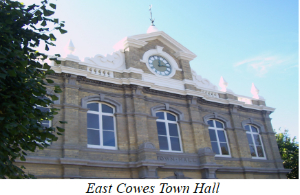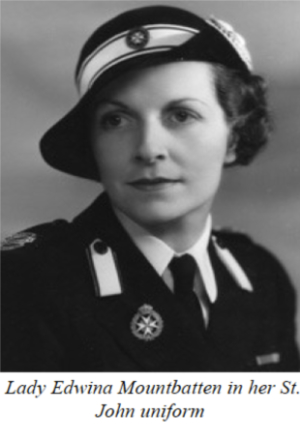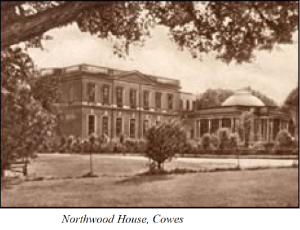
St. John Ambulance Brigade Report in the Aftermath of the Cowes Blitz
The Society has received an archived report from Derek Lammers-Wood of Newport (IW) St. John Ambulance organisation, which he discovered recently and kindly thought we might be interested in. The report was written by Mr. G. Thompson, Divisional Secretary of the Cowes and East Cowes Division of SJA in the aftermath of the Cowes Blitz in May 1942.
As an introduction, Derek wrote:
“The night of 4th May is forever etched in the history of Cowes: a night when the town, along with East Cowes, was directly targeted by the Luftwaffe, intent on destroying the shipyards of the town. Much has been written about the heroic acts of the captain and crew of the Polish warship ORP Blyskawica and the pivotal role the ship played in the defence of the towns. What is not so well-known is the role that residents who, as members of St. John Ambulance and the ARP Service, played during and after the devastating attack"
WORK OF THE MEMBERS OF ST. JOHN AMBULANCE BRIGADE IN CONNECTION WITH AIR RAID AT COWES AND EAST COWES 4th-5th MAY 1942
Two heavy raids on Cowes and East Cowes took place during the night of 4th-5th May, the first at about 11pm and the second about 4am.
As was to be expected, the Brigade on the Island played an important part. The Area Staff and seven Ambulance Divisions (Cowes and East Cowes; Yarmouth; Freshwater and Totland; Ryde;Newport; Bembridge and SARO* (East Cowes) supplied members for first aid duties, and threefurther divisions (Sandown, Shanklin and Ventnor) and two Cadet Ambulance Divisions (Cowesand East Cowes Nos 1 and 2) supplied members for other duties in connection with the raid. *Saunders Roe
COWES AND EAST COWES AMBULANCE DIVISION
As might be expected, the brunt of the work fell on this division. No 3 First Aid Party, which consisted of Sergeants Walkinshaw and Simpson, and Privates Roy and Steed, was on duty at the East Cowes Town Hall when the first raid commenced.

At 11.45pm a call came for a First Aid Party to be sent to Cambridge Road. No.3 Party was dispatched, and on arrival found that a high-explosive bomb had fallen in a back garden, damaging two houses. It was reported that six people were trapped under one of the houses. A rescue Party arrived at the same time as the First Aid Party, and their leader Private Cross lost no time in finding the best way to reach the trapped people. The explosion had razed the houses to the ground, leaving the gable end of one standing treacherously upright in the misty red glow of the fires and smoke around. Hearing cries coming from the rear of the house, and at the base of this gable end, Private Cross took charge of operations. With courage and splendid leadership he, assisted by Privates Cooke and Cunningham, members of the Party, proceeded to clear the debris, and after much hard work with bare hands and a small shovel, succeeded in tunnelling under the wreckage, and located the first casualty. In spite of the dangerous condition of the high wall standing over them they continued working until they succeeded in extricating all occupants of the house: one man, two women and three children.
The First Aid Party had in the meantime prepared stretchers and brought them to the top of the tunnel, ready to receive the patients as they were handed up from below. The first to be removed was a boy of four years of age, who was suffering from severe shock. He was wrapped in blankets, given some hot, sweet tea, and placed in the ambulance to wait for his mother, who was next to be moved. She was treated for a suspected fracture of the left wrist. As it was obvious that it would be some time before anyone else could be rescued, the ambulance was sent away with these two patients, so that they could be taken away to safety, and thus reduce their mental anxiety, as the raid was still in progress.
Two girls, aged 12 and 7, were the next to be handed out. One was suffering from a fracture of the left leg, and the other was badly bruised. The fracture was treated and both girls were kept warm, the less severely injured one helping to cheer her sister, until another person was brought out. This casualty, a man, was suffering from a fractured skull and was unconscious. These three patients were then removed to hospital by ambulance.
The last case to be rescued was a woman, who was found to be badly injured. Owing to the darkness and debris it was decided not to attend to any of her injuries on the spot, but to get her to hospital as soon as possible. On arrival, however, it was found that she was dead.
No.3 First Aid Party then reported back to the Town Hall to await further calls.
(Sergeant Walkinshaw of Cowes and East Cowes Ambulance Division, subsequently reporting on the work of Private Cross and his rescue party, said that they worked under very dangerous conditions, with complete disregard for their own safety, yet removed their casualties with a minimum of discomfort to those concerned. In recognition of their work Privates Cross, Cooke and Cunningham were later awarded Certificates of Meritorious Service by the Chief Commissioner.
These were presented by the Lady County President, Lady Louis Mountbatten, at an inspection of the Division on 21st June 1942.)

On the west side of the river ambulance crews form Cowes and East Cowes Divisions were active during the night: Corporal Watson went to an incident at Hill View Terrace, where he performed artificial respiration on two children, both of whom were unfortunately beyond aid. He then found a casualty with a fractured arm, which he splinted and dispatched the patient to hospital in an ambulance. Corporal Watson then went to Arctic Road, where he helped Nurse Edwards to attend a male patient with a lacerated hip. He supervised the loading of an ambulance and then went to Northwood House.

Private Wilson was on duty at Messrs. J. Samuel White’s factory. He treated one fireman for burns and another for a lacerated arm, and gave shock treatment to a girl in a shelter. This work was carried out during the actual raid. Private Colley joined a fire party and obtaining a pump from Messrs. Saunders-Roe, helped to fight a fire at Messrs. Pickford’s store. Corporal Lavery, who was on night work at Messrs. J.S White’s factory, attended a girl in shock during the bombing. He went to Northwood House to join his First Aid party, and from there went to Baring Road, where at “Craithie” one man and two women were found to be dead in a house which had received a direct hit. Corporal Lavery the returned to Northwood House, where he assisted with the casualties coming in, some of them being dead. Sergeant Hartley was also on duty at Northwood house. In addition to the First Aid work carried out, mention must be made of the services of Private Meader as as messenger. Twice during the raid he went to Newport on a motorcycle to deliver important messages, as all telephone communications broke down ten minutes after the bombing commenced. Two St. John Ambulance Association members, Police Constables Denness and Booker, also did very valuable work during the raids. PC Denness was Incident Officer at the Castle Street and Cambridge Road incidents, and both men did an great deal to assist the First Aid parties during the night. (Cowes and East Cowes Ambulance Divisions 1 and 2 were reported to have acted mainly as messengers. Several cadets were commended for their additional actions. The Report then details other contributions made by other Island Ambulance Divisions: Yarmouth, Freshwater and Totland, Ryde, Newport and Bembridge, along with SARO’s East Cowes Ambulance Division.)